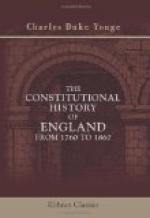[Footnote 253: See ante, p. 127.]
[Footnote 254: In one instance the rebels were aided by a party of citizens of the United States, who, without any sanction from their own government, seized an island on the St. Lawrence belonging to us, and attacked some of the Canadian villages. And this led to the discussion of a question of international combined with constitutional law, which Lord Campbell thus describes: “’Whether, if the subjects or citizens of a foreign state with which we are at peace, without commission or authority from their own or any other government, invade the English territory in a hostile manner, and levy war against the Queen in her realm, we are entitled to treat them as traitors?’ The Canadian courts held that we could not, as they had never acknowledged even a temporary allegiance to our sovereign. And of this opinion was Sir William Follett. But, after reading all that is to be found on the subject, I come to the conclusion that they owed allegiance when, as private individuals, they voluntarily crossed the English frontier; that it was no defence for them to say that they then had arms in their hands and intended to murder the Queen’s subjects.”—Life of Lord Campbell, ii.,119. It certainly would have been no defence; but would it not have taken their conduct from under the definition of treason, and made it an act of piracy?]
[Footnote 255: See Fox’s words, quoted by Lord Stanhope.—Life of Pitt, ii., 90.]
[Footnote 256: A couple of years after the period which is the boundary of the present work, this Canadian constitution of 1841 was superseded by a measure uniting Canada, Nova Scotia, and New Brunswick in one federal government, with, as the act recites, “a constitution similar in principle to that of the United Kingdom.” The act farther provided for the admission of other dependencies of the crown in North America, Newfoundland, Prince Edward Island, British Columbia, and Rupert’s Land into the union, and established as the constitution of the whole one scarcely differing from that of 1841, with the exception that both the Houses of the Legislature—called in the act the Senate and the House of Commons—were to be representative bodies, and that powers were conferred on them so absolutely free and independent, that it was thought necessary to add a clause providing that their “privileges, immunities, and powers were never to exceed those at the passing of the act held, enjoyed, and exercised by the Commons House of Parliament of the United Kingdom of Great Britain and Ireland, and by the members thereof.”]




